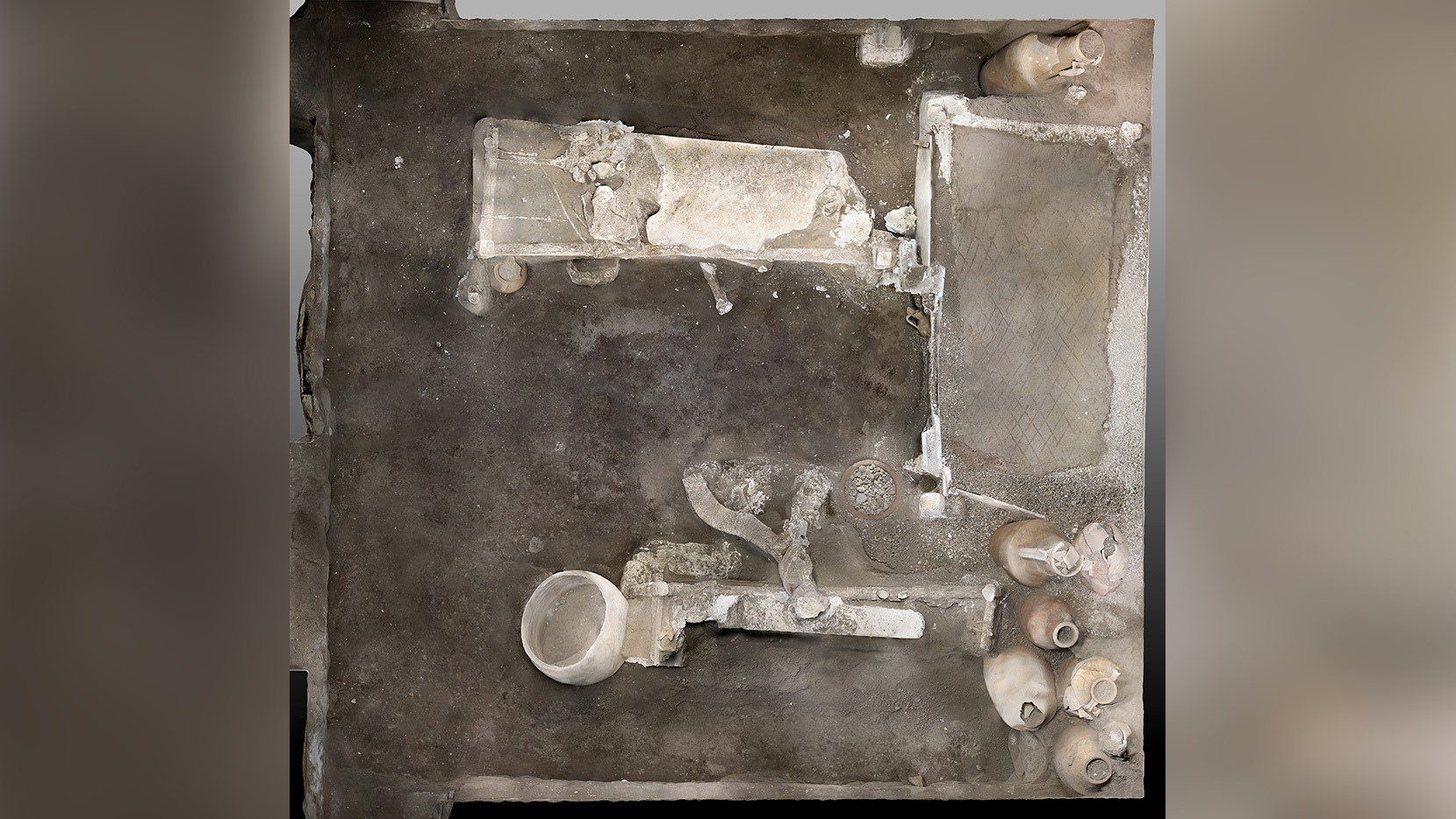Archaeologists uncover tiny room belonging to family of slaves in Pompeii
The 'slave room' was likely home to three people, one possibly a child.

Archaeologists in Pompeii have uncovered a tiny bedroom for slaves inside a Roman villa. The cramped room, which also doubled as a storage room, was most likely shared by three people, who may have been related.
The "slave room," which is around 172 square feet (16 square meters), contains three beds, a chamber pot and several metallic and fabric objects, as well as eight large ceramic jars. The archaeologists recently unearthed the room at Civita Giuliana, a large villa on the northern outskirts of Pompeii, according to a statement released Nov. 6 by The Archaeological Park of Pompeii.
Recent discoveries at the villa include a ceremonial chariot and the remains of three horses in close proximity to the new room. Part of a harness was also found among the inhabitants' possessions, which suggests that the slaves who lived in the room probably maintained the villa's stables.
Related: 15 incredible places on Earth that are frozen in time
"This is a window into the precarious reality of people who seldom appear in historical sources," Gabriel Zuchtriegel, director general at The Archaeological Park of Pompeii, said in the statement. "It helps us to discover a part of the ancient world which we would otherwise know little about, but which is nonetheless extremely important."
The villa and slave room were frozen in time along with the rest of Pompeii when the nearby Mount Vesuvius erupted in A.D. 79 and destroyed the town, preserving it in a thick layer of volcanic ash.
Cramped conditions
The researchers were particularly surprised at just how small the slaves' living quarters were. "What is most striking is the cramped and precarious nature of this room, which was something between a dormitory and a storage room," Zuchtriegel said in the statement.
Sign up for the Live Science daily newsletter now
Get the world’s most fascinating discoveries delivered straight to your inbox.
The inhabitants likely stored their limited possessions in the room's large chest and under their beds. However, the remaining free space in the room was occupied by ceramic jars, also known as amphorae, which would have most likely been used to store supplies for the villa.
The only light in the room would have come from a small upper window, and there is no evidence of any wall decorations in the room, according to the statement.

The beds are made from wooden planks and posts with a rope base covered in blankets. Two of the beds measure around 5 feet and 7 inches (1.7 meters) long, while the other one measures just 4 feet and 7 inches (1.4 m). The researchers suspect that the smaller bed may have belonged to a child, which suggests the inhabitants of the room could have been a family unit, according to the statement.
Hidden history
Historians have long known that slavery played a key role in the rise and success of the Roman Empire. However, researchers have uncovered little direct evidence of how slaves were treated by their masters. This new discovery provides a rare and unique glimpse into the dynamic between slaves and owners.
Most historical accounts are "written almost exclusively by men belonging to the elite,'' which often means the lower classes, including slaves, "risk remaining invisible in the great historical accounts," Zuchtriegel said.
The researchers hope that further analysis of the room will uncover more clues about the slaves' lives and slavery in general across the Roman Empire.
"It is certainly one of the most exciting discoveries during my life as an archaeologist, even without the presence of great treasures," Zuchtriegel said in the statement. "The true treasure here is the human experience" and learning more about "the most vulnerable members of ancient society," he added.
Originally published on Live Science.

Harry is a U.K.-based senior staff writer at Live Science. He studied marine biology at the University of Exeter before training to become a journalist. He covers a wide range of topics including space exploration, planetary science, space weather, climate change, animal behavior and paleontology. His recent work on the solar maximum won "best space submission" at the 2024 Aerospace Media Awards and was shortlisted in the "top scoop" category at the NCTJ Awards for Excellence in 2023. He also writes Live Science's weekly Earth from space series.










